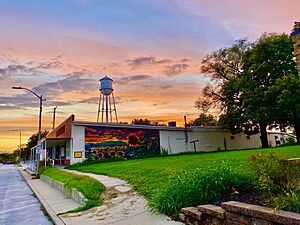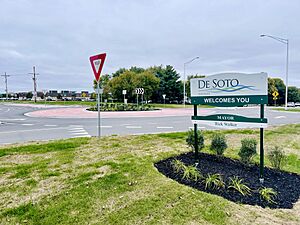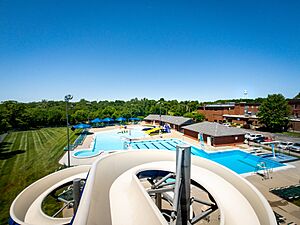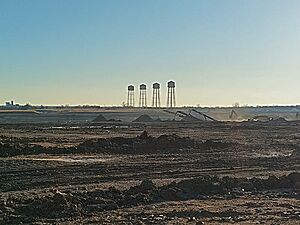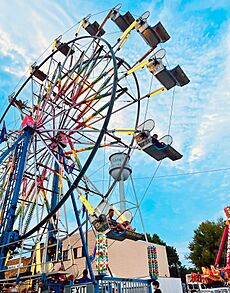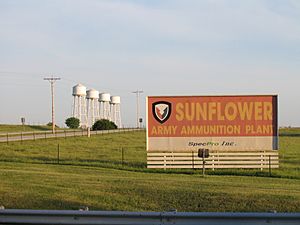De Soto, Kansas facts for kids
Quick facts for kids
De Soto, Kansas
|
||
|---|---|---|
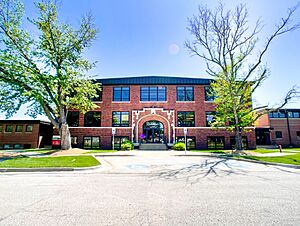
De Soto City Hall (2022)
|
||
|
||
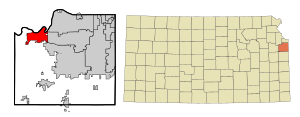
Location within Johnson County and Kansas
|
||

|
||
| Country | United States | |
| State | Kansas | |
| Counties | Johnson, Leavenworth | |
| Townships | Lexington, Sherman | |
| Founded | 1828 | |
| Platted | 1857 | |
| Incorporated | October 1, 1897 | |
| Named for | Hernando de Soto | |
| Government | ||
| • Type | Mayor–Council | |
| Area | ||
| • Total | 11.28 sq mi (29.22 km2) | |
| • Land | 11.15 sq mi (28.89 km2) | |
| • Water | 0.13 sq mi (0.33 km2) | |
| Elevation | 853 ft (260 m) | |
| Population
(2020)
|
||
| • Total | 6,118 | |
| • Density | 542.38/sq mi (209.38/km2) | |
| Time zone | UTC-6 (CST) | |
| • Summer (DST) | UTC-5 (CDT) | |
| ZIP codes |
66018, 66019, 66025, 66061
|
|
| Area code | 913 | |
| FIPS code | 20-17850 | |
| GNIS ID | 485562 | |
De Soto is a city in Kansas, located along the Kansas River. It spans parts of Johnson and Leavenworth counties. De Soto is also part of the larger Kansas City Metropolitan Area. In 2020, about 6,118 people lived here. By 2021, the population was estimated to be around 6,380.
Contents
History
The land where De Soto now stands was once home to the Osage people. Later, the Shawnee people were moved here from other areas. In 1828, a group of Shawnee settled near the Kansas River. Many other Native American tribes also came to this area in the 1800s. They were often pushed west by European-American settlers. A mission was built in the De Soto area to help the Shawnee tribe.
The city of De Soto was officially planned in 1857. It was named after Hernando de Soto, a Spanish explorer from the 1500s. Early landowners helped build the town. De Soto became an official city on October 1, 1897.
In the early 1940s, during World War II, the Sunflower Army Ammunition Plant was built south of De Soto. This huge plant made ammunition for the war. Many people moved to De Soto to work there, and the city's population grew quickly. This put a strain on housing and other resources. The plant stopped making ammunition in 1993.
Clearview City
In 1943, a place called Sunflower Village was built. It provided homes for workers at the Sunflower Ordnance Works. There were many houses, and the area became very crowded. People even lived in trailers and tents. In 1961, Sunflower Village was renamed Clearview City. Later, in 1998, Clearview City became part of De Soto. This added 339 people to De Soto's population.
The Great Flood of 1951
In July 1951, very heavy rains caused a huge flood. The Kansas River overflowed its banks. De Soto, which is on the south side of the river, was badly damaged. The river reached its highest point ever recorded in De Soto. Much of the downtown area was completely underwater. In some places, the water was over 4 feet deep.
Recent Growth
After the 2008 recession, De Soto started to grow again. Many new businesses have opened, especially near the K-10 highway. In 2019, a newspaper reported that De Soto was one of the fastest-growing cities in the Kansas City area.
After the Sunflower Army Ammunition Plant closed, there were many plans for the large area it used to cover. In 2019, lawmakers asked the Army to clean up the land faster. By 2020, parts of the land closest to De Soto were ready for new development.
In April 2021, a company called Flint Logistics proposed building a large logistics center and homes. This project would be west of De Soto.
In 2021, the U.S. Army Corps of Engineers said that the northern part of the former ammunition plant was clean and ready for building. De Soto then expanded its city limits to include about 10 square miles of this land. This almost doubled the city's size. The city also made plans to improve roads and utilities in the area.
In July 2022, a big announcement was made. Panasonic North America decided to build its first U.S. electric vehicle battery factory in De Soto. This factory will be on the land where the Sunflower Army Ammunition Plant used to be. Panasonic is investing over $4 billion, making it the largest private investment in Kansas' history. It is expected to create 4,000 direct jobs.
In October 2022, De Soto added another 2,800 acres of the former ammunition plant land. This completed the annexation of the entire 17-square-mile property. The former ammunition plant site was renamed Astra Enterprise Park in November 2022.
Geography
De Soto covers about 11.28 square miles. Most of the city is in Johnson County. A golf course north of the Kansas River is in Leavenworth County. De Soto is mainly south of the Kansas River. Several creeks, like Captain Creek and Kill Creek, flow into the Kansas River within the city limits.
Many people think of De Soto as an exurb. This means it's a community outside the main Kansas City metropolitan area, but still connected to it. De Soto borders other cities like Shawnee to the northeast, Lenexa to the east, and Olathe to the southeast.
Demographics
| Historical population | |||
|---|---|---|---|
| Census | Pop. | %± | |
| 1860 | 35 | — | |
| 1870 | 102 | 191.4% | |
| 1880 | 141 | 38.2% | |
| 1890 | 223 | 58.2% | |
| 1900 | 226 | 1.3% | |
| 1910 | 240 | 6.2% | |
| 1920 | 255 | 6.3% | |
| 1930 | 384 | 50.6% | |
| 1940 | 383 | −0.3% | |
| 1950 | 518 | 35.2% | |
| 1960 | 1,271 | 145.4% | |
| 1970 | 1,839 | 44.7% | |
| 1980 | 2,061 | 12.1% | |
| 1990 | 2,291 | 11.2% | |
| 2000 | 4,561 | 99.1% | |
| 2010 | 5,720 | 25.4% | |
| 2020 | 6,118 | 7.0% | |
| U.S. Decennial Census 2010-2020 |
|||
What the 2020 Census Shows
In 2020, the 2020 United States census counted 6,118 people living in De Soto. There were 2,295 households and 1,635 families. Most residents, about 79.88%, were white. Other groups included African American, Native American, and Asian people. About 16.92% of the population was Hispanic or Latino.
About 35.4% of households had children under 18. Most households (57.2%) were married couples. The average household had 2.8 people. The average family had 3.4 people.
The median age in De Soto was 39.4 years old. About 24.1% of the population was under 18. About 15.0% were 65 or older.
Economy
De Soto is home to several important companies. Great American Bank and Custom Foods, Inc. have their main offices here. Goodcents Deli Fresh Subs also has its headquarters in De Soto.
International companies like Huhtamaki Americas, Inc. and Engineered Air have their North American headquarters in De Soto. Merck Animal Health, a big name in animal health, has one of its U.S. factories here. Rehrig Pacific, which makes plastics, also has operations in De Soto. In 2019, Biodesix, a company that researches lung cancer, opened a lab in the city.
Panasonic Battery Plant
In 2021, the U.S. Army Corps of Engineers gave permission to develop the northern part of the former Sunflower Army Ammunition Plant. De Soto then expanded its city limits to include this large area. The city also created a special funding district to help new businesses come in.
In early 2022, Kansas lawmakers passed a bill to offer tax breaks for a huge project. This project was worth $4 billion. It was thought to be either in De Soto or Oklahoma.
On July 13, 2022, it was announced that Panasonic chose De Soto for its new electric-vehicle battery factory. This factory will be built on the old ammunition plant site. It is the biggest single investment in Kansas' history. The factory is expected to create 4,000 direct jobs. It will also create 4,000 more jobs in related businesses. Another 16,000 jobs will be created during construction. The factory is expected to open in July 2024.
Largest Employers
As of 2020, these are the largest employers in De Soto:
| # | Employer | # of Employees |
|---|---|---|
| 1 | De Soto School District | 1,655 |
| 2 | Engineered Air | 870 |
| 3 | Huhtamaki | 640 |
| 4 | Merck Animal Health | 180 |
| 5 | Rehrig Pacific | 110 |
| 6 | Custom Foods Inc | 110 |
| 7 | Goodcent's Deli Fresh Subs Headquarters | 95 |
| 8 | Hillside Village | 86 |
Arts and Culture
A historic barn, built in the 1880s, was moved to a farm in De Soto. It was rebuilt in 2000 and became known as the Zimmerman barn. People could rent it for events like weddings. A storm destroyed the barn in 2010, but it was rebuilt in 2013.
Some movies and books have connections to De Soto:
- The movie The Day After was filmed partly on K-10 highway in De Soto.
- The movie All Creatures Here Below is partly set in De Soto.
- The science fiction novel The Calculating Stars features the Sunflower Army Ammunition Plant. In the book, it becomes a major spaceport.
Official Ice Cream Flavor
In 2024, De Soto got its own official ice cream flavor: Chocolate Chip. The city's young residents chose the flavor during a special "Government Day" event. This shows how young people are involved in local traditions.
Events
- De Soto Days Festival - This is an annual festival that starts before Labor Day. It lasts for three days and has booths and three stages with entertainment.
- Winesong at Riverfest - This wine festival started in 2012. It is hosted by the De Soto Rotary Club in early June. It features wineries from the Midwest, along with food, music, and art.
Education
De Soto is part of the De Soto USD 232 public school district. The district has two high schools: De Soto High School (in De Soto) and Mill Valley High School (in Shawnee).
Library
The Johnson County Library System has a branch called the De Soto Downtown Library.
Media
Newspapers
The De Soto Explorer was the city's main newspaper from 1998 to 2012. In 2015, Discovering De Soto magazine started. The De Soto City Council helps fund this magazine.
The The Kansas City Star and the Lawrence Journal-World newspapers also cover news in De Soto.
Transportation
Roads
Several highways serve De Soto:
 K-10 runs through the southern part of De Soto. It has four exits that connect directly to the city.
K-10 runs through the southern part of De Soto. It has four exits that connect directly to the city. K-32 is about 5 miles north of De Soto.
K-32 is about 5 miles north of De Soto. US-24/
US-24/ US-40 run together about 7 miles north of De Soto.
US-40 run together about 7 miles north of De Soto.- Other county roads also provide connections.
- West 103rd Street, also known as Lexington Avenue and West 83rd Street, runs through De Soto. It connects the city to Shawnee, Lenexa, Overland Park, and Kansas City.
Rail
De Soto was founded along the Kansas River. In 1857, the Atchison, Topeka, Santa Fe Railway built tracks through the northern part of town. De Soto had a train depot around 1860. A railyard was built east of town in 1900 to switch freight cars. Parts of this railyard are still used today.
In 1942, during the building of the Sunflower Army Ammunition Plant, the U.S. Army built a special rail line. This line connected the plant to the main railway. This line is still used for industrial shipments today.
Notable People
Here are some notable people who have lived in or were born in De Soto:
- Stanley Adams (1922-1999), a U.S. Army Lieutenant Colonel and Medal of Honor winner.
- Mandy Chick (born 2001), an American stock car racer.
- Howard Gloyd (1902-1978), a scientist who studied reptiles.
- Greyson Jenista (1996), a baseball player for the Atlanta Braves minor league.
- Frank Lee (1873-1952), a U.S. Representative from Missouri.
- John Outland (1871-1941), an American Football Player and Coach.
- Kenneth Spencer (1902-1960), a coal mine owner and generous giver.
See also
 In Spanish: De Soto (Kansas) para niños
In Spanish: De Soto (Kansas) para niños



